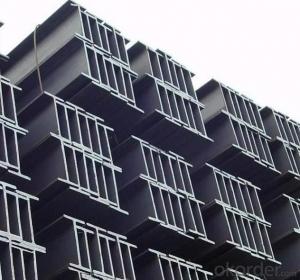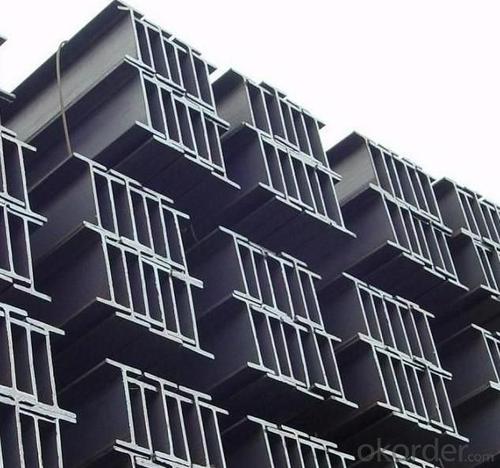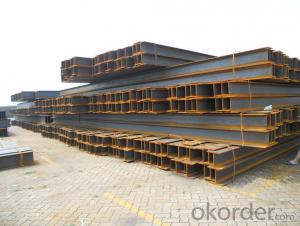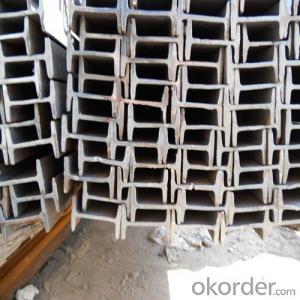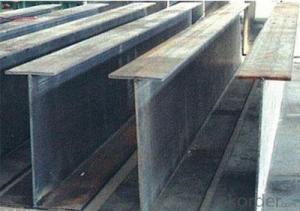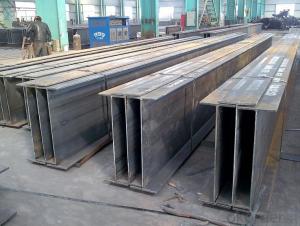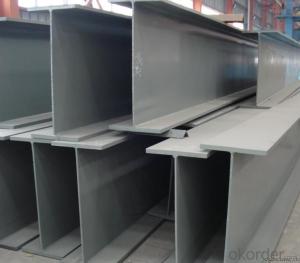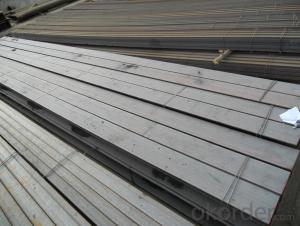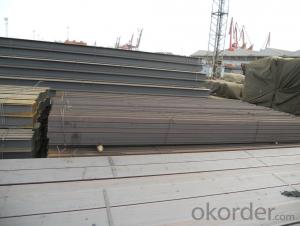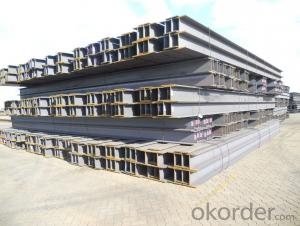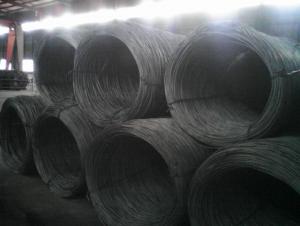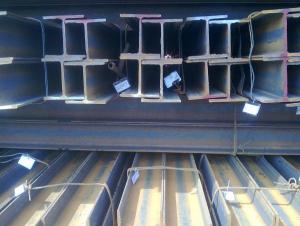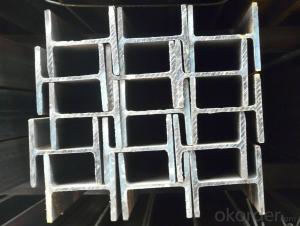Japanese Standard SS400 H beam with High Quality 446mm-498mm
- Loading Port:
- Tianjin
- Payment Terms:
- TT OR LC
- Min Order Qty:
- 100 m.t
- Supply Capability:
- 15000 m.t/month
OKorder Service Pledge
OKorder Financial Service
You Might Also Like
Specification
Specifications of Japanese Standard SS400 H beam with High Quality 446mm-498mm:
1. Standard: JIS 3192
2. Grade: SS400 or Equivalent
3. Length: 10m, 12m as following table
4. Invoicing on theoretical weight or actual weight as customer request
5.Payment: TT or L/C
Size and Mass of Japanese Standard SS400 H beam with High Quality 446mm-498mm:
| Size(mm) | Mass (Kg/m) | Size (mm) | Mass (Kg/m) |
| 458*417*30.0 | 415 | 446*199*8.0 | 65.1 |
| 498*432*45.0 | 605 | 450*200*9.0 | 74.9 |
Packaging & Delivery of Japanese Standard SS400 H beam with High Quality 446mm-498mm for Building Structures:
1. Packing: it is nude packed in bundles by steel wire rod
2. Bundle weight: not more than 3.5MT for bulk vessel; less than 3 MT for container load
3. Marks:
Color marking: There will be color marking on both end of the bundle for the cargo delivered by bulk vessel. That makes it easily to distinguish at the destination port.
Tag mark: there will be tag mark tied up on the bundles. The information usually including supplier logo and name, product name, made in China, shipping marks and other information request by the customer.
If loading by container the marking is not needed, but we will prepare it as customer request.
4. Transportation: the goods are delivered by truck from mill to loading port, the maximum quantity can be loaded is around 40MTs by each truck. If the order quantity cannot reach the full truck loaded, the transportation cost per ton will be little higher than full load.
5. Delivered by container or bulk vessel.
Usage of Japanese Standard SS400 H beam with High Quality 446mm-498mm:
(1). for the plant, high-rise building construction
(2). for the bridge, shipment building
(3).for lifting and transportation machinery, equipment manufacturing base building
(4). for the support, foundation pile manufacturing
FAQ:
Q1: Why buy Materials & Equipment from OKorder.com?
A1: All products offered by OKorder.com are carefully selected from China's most reliable manufacturing enterprises. Through its ISO certifications, OKorder.com adheres to the highest standards and a commitment to supply chain safety and customer satisfaction.
Q2: How do we guarantee the quality of our products?
A2: We have established an advanced quality management system which conducts strict quality tests at every step, from raw materials to the final product. At the same time, we provide extensive follow-up service assurances as required.
Q3: How soon can we receive the product after purchase?
A3: Within three days of placing an order, we will arrange production. The shipping date is dependent upon the quatity, how many sizes you want and the plan of production, but is typically 1 month to 2 months from the beginning of production.
Images of Japanese Standard SS400 H beam with High Quality 446mm-498mm:
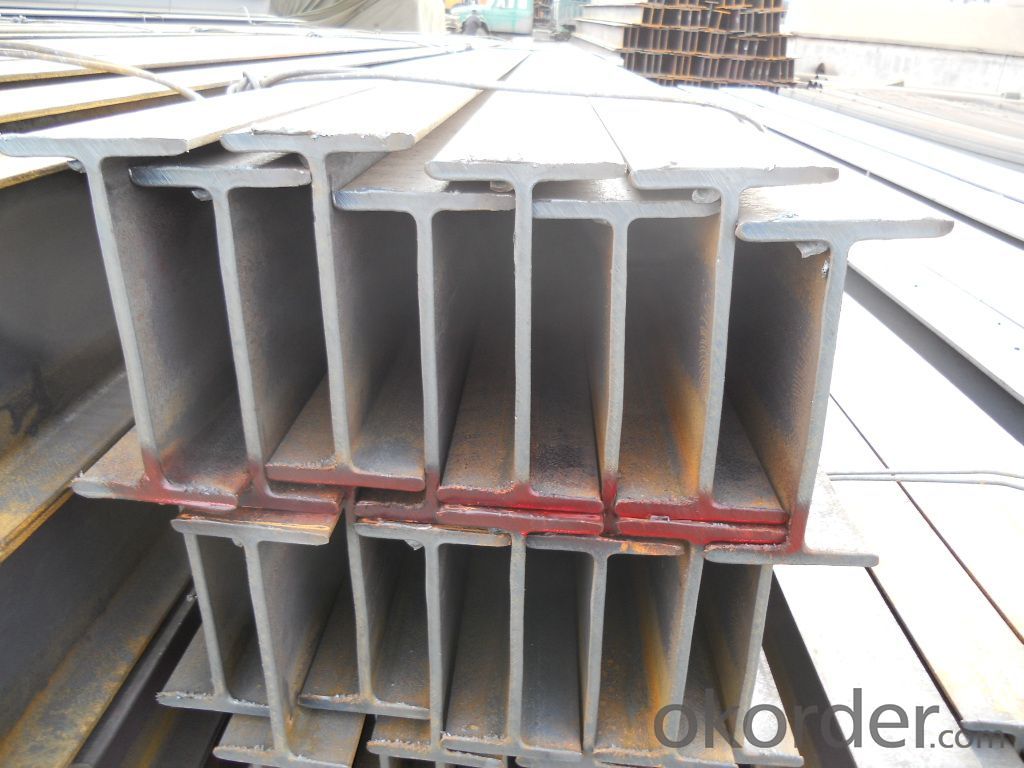
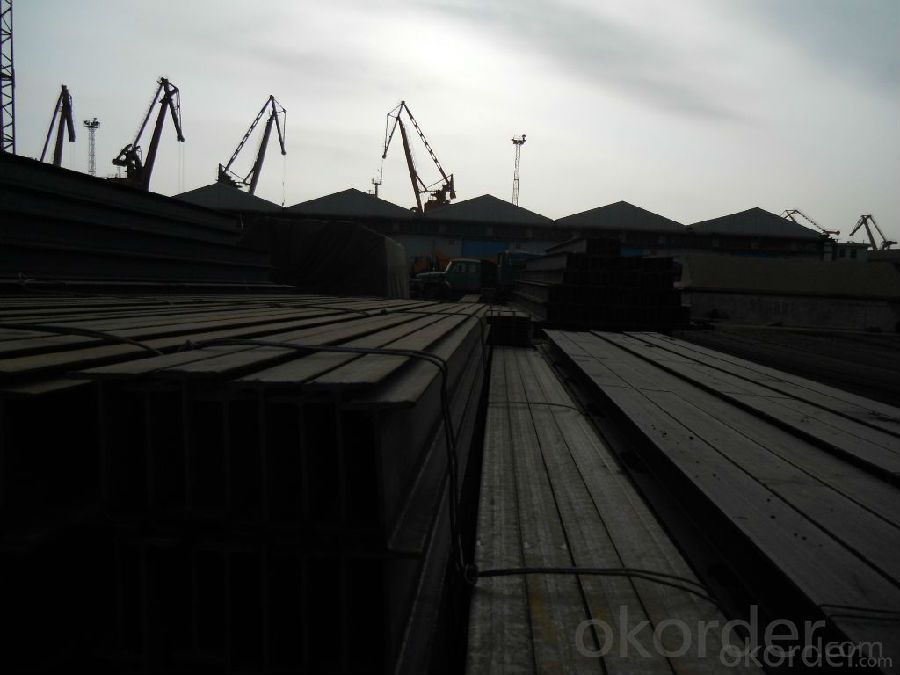
* If you would like to get our price, please inform us the size, standard/material and quantity. Thank you very much for your attention.
- Q: How do steel H-beams perform in terms of thermal insulation?
- Steel H-beams do not perform well in terms of thermal insulation. Steel is a good conductor of heat, meaning it easily allows heat to pass through it. As a result, steel H-beams can contribute to heat loss or gain in a building, making them less effective in providing thermal insulation compared to materials with better insulating properties, such as wood or insulation materials.
- Q: Can steel H-beams be used for railway bridges or overpasses?
- Certainly! Steel H-beams are a viable option for railway bridges or overpasses. They are widely used in construction owing to their remarkable strength-to-weight ratio, rendering them suitable for bearing heavy loads. The materials required for railway bridges and overpasses must be robust and enduring to support the weight of trains, and steel H-beams are well-suited for this purpose. They provide structural stability, possess the ability to endure significant loads and forces, and can span considerable distances. Moreover, steel H-beams possess resistance against corrosion, a crucial attribute for structures exposed to the elements. All in all, due to their strength, durability, and versatility, steel H-beams are a favored choice for railway bridges and overpasses.
- Q: How do steel H-beams contribute to the overall stability of a structure?
- Steel H-beams contribute to the overall stability of a structure by providing strength and support. The H-shape design allows for better load distribution, minimizing deflection and preventing the structure from bending or collapsing under heavy loads. Additionally, the vertical web of the H-beam adds rigidity and stability, ensuring the structure can withstand various forces, such as wind or seismic loads, without compromising its integrity.
- Q: Are steel H-beams resistant to electrical conductivity?
- Yes, steel H-beams are generally resistant to electrical conductivity. Steel is a poor conductor of electricity, so H-beams made from steel do not easily allow the flow of electrical current.
- Q: Can steel H-beams be used in the construction of residential towers or skyscrapers?
- Steel H-beams, also known as I-beams, can be utilized in the construction of residential towers or skyscrapers. These structural steel beams, shaped like an "H," are widely employed in the construction industry due to their high strength-to-weight ratio, versatility, and cost-effectiveness. To withstand the forces and loads exerted on residential towers and skyscrapers, robust structural elements are required. Steel H-beams are exceptional in meeting these requirements. Their design allows for efficient weight and force distribution, making them ideal for supporting heavy loads over long spans. Additionally, their shape provides resistance against bending and twisting, enhancing the structural integrity of the building. The durability, longevity, and ease of installation of steel H-beams make them commonly used in the construction industry. They can be fabricated to precise specifications, ensuring a consistent and reliable structural system. Furthermore, they can be easily connected and assembled on-site, reducing construction time and costs. The utilization of steel H-beams in residential towers and skyscrapers allows for flexible designs and layouts. These beams can support various floor plans, open spaces, and architectural features. They also offer the possibility of creating large, column-free spaces, which is highly desired in modern building designs. Moreover, steel is a sustainable and environmentally friendly construction material. It is 100% recyclable and can be reused without losing its properties. This makes steel H-beams an attractive option for developers and architects who prioritize green building practices. In conclusion, steel H-beams are well-suited for the construction of residential towers or skyscrapers. Their strength, versatility, cost-effectiveness, and sustainability make them an excellent choice for supporting heavy loads and providing a reliable structural system in high-rise buildings.
- Q: Can steel H-beams be used in seismic zones?
- Yes, steel H-beams can be used in seismic zones. Steel has high strength and ductility, making it suitable for withstanding seismic forces. Additionally, H-beams are designed to distribute loads and resist bending, making them a commonly used structural element in seismic-resistant construction. However, it is important to ensure that the design and installation of H-beams in seismic zones comply with local building codes and regulations to ensure the safety and stability of the structure.
- Q: Are steel H-beams suitable for use in the construction of cultural centers or theaters?
- Yes, steel H-beams are suitable for use in the construction of cultural centers or theaters. Steel H-beams are widely used in construction projects due to their high strength-to-weight ratio, durability, and ability to withstand heavy loads. In the case of cultural centers or theaters, where large open spaces and long spans are often required, steel H-beams provide the necessary structural support while allowing for flexible design options. Additionally, steel H-beams are fire-resistant and can be easily fabricated and installed, making them a popular choice for such projects.
- Q: Are steel H-beams suitable for seismic zones?
- Steel H-beams are indeed suitable for seismic zones. Due to its high durability and ductility, steel has been widely utilized in areas prone to seismic activity. Specifically designed to provide structural support and stability, H-beams, also referred to as I-beams, are well-suited for seismic zones. The distinctive shape of H-beams, featuring a wider flange and narrower web, enables them to evenly and efficiently distribute loads. This design enhances their load-bearing capacity and resistance to bending moments, making them ideal for seismic conditions. Additionally, the cross-sectional shape of H-beams provides excellent resistance against lateral forces commonly experienced during seismic events. Moreover, steel H-beams can be fabricated to meet specific seismic design requirements. They can be reinforced with additional steel plates or braces to enhance their strength and stiffness. These beams can also be designed to offer flexibility and ductility, crucial in absorbing and dissipating energy during earthquakes. Furthermore, steel H-beams offer numerous advantages in seismic zones. They are non-combustible, minimizing the risk of fire-related incidents. Additionally, steel beams are lightweight compared to other construction materials, making them easier to transport and install in regions prone to earthquakes. Furthermore, steel is a recyclable material, contributing to sustainable construction practices. However, it is important to consider various factors, such as design considerations, foundation conditions, and local building codes, to determine the suitability of steel H-beams in seismic zones. Consulting with structural engineers and adhering to seismic design guidelines is essential to ensure the safe and effective utilization of steel H-beams in seismic regions.
- Q: What are the maximum spans for steel H-beams?
- The maximum spans of steel H-beams are influenced by various factors, including the size of the beam, the applied load, and the design criteria. In general, steel H-beams have longer spans compared to other beam types due to their superior strength and capacity to bear heavy loads. The maximum spans of steel H-beams can range from a few meters to more than 20 meters, depending on the specific requirements of the structure. Smaller H-beams, like W4x13 or W5x19, may have limited maximum spans of only a few meters. Conversely, larger H-beams, such as W36x300 or W40x327, can achieve spans exceeding 20 meters, and sometimes even more. It is important to consider that the maximum span is also influenced by the load applied to the beam. To determine the appropriate maximum span for a steel H-beam in a particular application, it is necessary to consider the design criteria, which include factors like required deflection limits and safety factors. To summarize, the maximum spans of steel H-beams can vary significantly based on their size, load, and design criteria. Seeking guidance from a structural engineer or referring to relevant design codes and standards is essential to determine the maximum span for a specific steel H-beam in a given structural application.
- Q: How do steel H-beams compare to other building materials in terms of strength?
- The construction industry widely considers steel H-beams as one of the strongest building materials available. With its unique shape, the H-beam offers exceptional strength and structural integrity, making it highly suitable for various applications. Compared to wood, concrete, or aluminum, steel H-beams provide significant advantages in terms of strength. The high tensile strength of steel allows H-beams to withstand heavy loads and resist bending or warping under pressure. This makes them ideal for supporting large structures and heavy equipment. Furthermore, steel H-beams have a higher strength-to-weight ratio compared to materials like wood or concrete. This means that steel can withstand greater loads while being relatively lighter in weight. As a result, steel H-beams are easier to transport and install. The strength of H-beams also allows for longer spans between support points, reducing the need for additional columns or supports and maximizing space utilization in a building. In addition to their superior strength, steel H-beams also offer exceptional durability and longevity. Steel resists corrosion, rot, and pests, which are common issues with materials like wood. This durability ensures that structures built with steel H-beams can withstand harsh weather conditions and require minimal maintenance over their lifespan. Overall, steel H-beams surpass other building materials in terms of strength, offering unparalleled structural integrity, a higher strength-to-weight ratio, and greater durability. These characteristics make them the preferred choice for a wide range of construction projects, including high-rise buildings, bridges, industrial facilities, and warehouses.
Send your message to us
Japanese Standard SS400 H beam with High Quality 446mm-498mm
- Loading Port:
- Tianjin
- Payment Terms:
- TT OR LC
- Min Order Qty:
- 100 m.t
- Supply Capability:
- 15000 m.t/month
OKorder Service Pledge
OKorder Financial Service
Similar products
Hot products
Hot Searches
Related keywords
